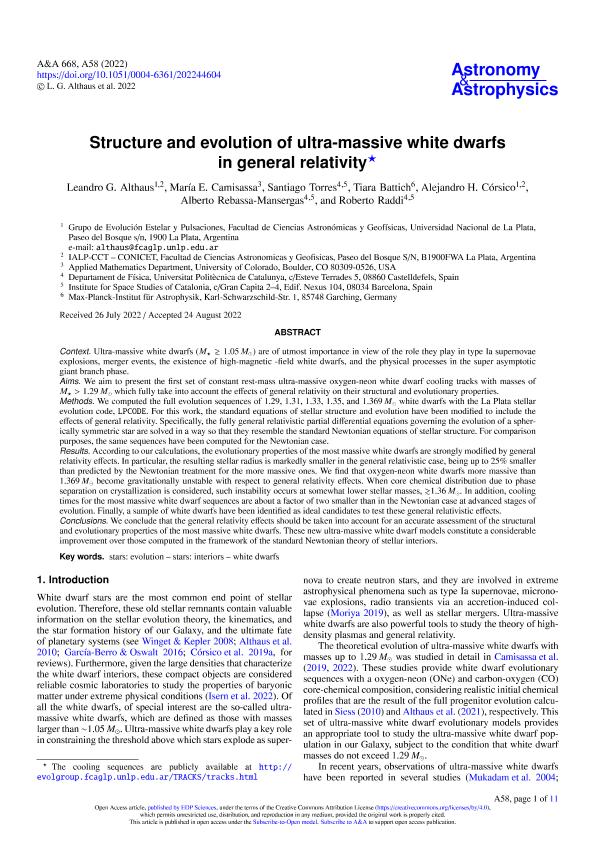Mostrar el registro sencillo del ítem
dc.contributor.author
Althaus, Leandro Gabriel

dc.contributor.author
Camisassa, María Eugenia

dc.contributor.author
Torres, Santiago Hernan

dc.contributor.author
Battich, Tiara

dc.contributor.author
Corsico, Alejandro Hugo

dc.contributor.author
Rebassa Mansergas, Alberto
dc.contributor.author
Raddi, Roberto Ariel
dc.date.available
2023-09-08T12:43:54Z
dc.date.issued
2022-12
dc.identifier.citation
Althaus, Leandro Gabriel; Camisassa, María Eugenia; Torres, Santiago Hernan; Battich, Tiara; Corsico, Alejandro Hugo; et al.; Structure and evolution of ultra-massive white dwarfs in general relativity; EDP Sciences; Astronomy and Astrophysics; 668; A58; 12-2022; 1-11
dc.identifier.issn
0004-6361
dc.identifier.uri
http://hdl.handle.net/11336/210892
dc.description.abstract
Context. Ultra-massive white dwarfs (M∗ ≳ 1.05 M⊙) are of utmost importance in view of the role they play in type Ia supernovae explosions, merger events, the existence of high-magnetic -field white dwarfs, and the physical processes in the super asymptotic giant branch phase. Aims. We aim to present the first set of constant rest-mass ultra-massive oxygen-neon white dwarf cooling tracks with masses of M∗ > 1.29 M⊙ which fully take into account the effects of general relativity on their structural and evolutionary properties. Methods. We computed the full evolution sequences of 1.29, 1.31, 1.33, 1.35, and 1.369 M⊙ white dwarfs with the La Plata stellar evolution code, LPCODE. For this work, the standard equations of stellar structure and evolution have been modified to include the effects of general relativity. Specifically, the fully general relativistic partial differential equations governing the evolution of a spherically symmetric star are solved in a way so that they resemble the standard Newtonian equations of stellar structure. For comparison purposes, the same sequences have been computed for the Newtonian case. Results. According to our calculations, the evolutionary properties of the most massive white dwarfs are strongly modified by general relativity effects. In particular, the resulting stellar radius is markedly smaller in the general relativistic case, being up to 25% smaller than predicted by the Newtonian treatment for the more massive ones. We find that oxygen-neon white dwarfs more massive than 1.369 M⊙ become gravitationally unstable with respect to general relativity effects. When core chemical distribution due to phase separation on crystallization is considered, such instability occurs at somewhat lower stellar masses, ≳1.36 M⊙. In addition, cooling times for the most massive white dwarf sequences are about a factor of two smaller than in the Newtonian case at advanced stages of evolution. Finally, a sample of white dwarfs have been identified as ideal candidates to test these general relativistic effects. Conclusions. We conclude that the general relativity effects should be taken into account for an accurate assessment of the structural and evolutionary properties of the most massive white dwarfs. These new ultra-massive white dwarf models constitute a considerable improvement over those computed in the framework of the standard Newtonian theory of stellar interiors.
dc.format
application/pdf
dc.language.iso
eng
dc.publisher
EDP Sciences

dc.rights
info:eu-repo/semantics/openAccess
dc.rights.uri
https://creativecommons.org/licenses/by/2.5/ar/
dc.subject
STARS: EVOLUTION
dc.subject
STARS: INTERIORS
dc.subject
WHITE DWARFS
dc.subject.classification
Astronomía

dc.subject.classification
Ciencias Físicas

dc.subject.classification
CIENCIAS NATURALES Y EXACTAS

dc.title
Structure and evolution of ultra-massive white dwarfs in general relativity
dc.type
info:eu-repo/semantics/article
dc.type
info:ar-repo/semantics/artículo
dc.type
info:eu-repo/semantics/publishedVersion
dc.date.updated
2023-09-05T18:03:00Z
dc.journal.volume
668
dc.journal.number
A58
dc.journal.pagination
1-11
dc.journal.pais
Francia

dc.journal.ciudad
Paris
dc.description.fil
Fil: Althaus, Leandro Gabriel. Consejo Nacional de Investigaciones Científicas y Técnicas. Centro Científico Tecnológico Conicet - La Plata. Instituto de Astrofísica La Plata. Universidad Nacional de La Plata. Facultad de Ciencias Astronómicas y Geofísicas. Instituto de Astrofísica La Plata; Argentina. Universidad Nacional de La Plata. Facultad de Ciencias Astronómicas y Geofísicas; Argentina
dc.description.fil
Fil: Camisassa, María Eugenia. State University of Colorado at Boulder; Estados Unidos. Consejo Nacional de Investigaciones Científicas y Técnicas. Centro Científico Tecnológico Conicet - La Plata. Instituto de Astrofísica La Plata. Universidad Nacional de La Plata. Facultad de Ciencias Astronómicas y Geofísicas. Instituto de Astrofísica La Plata; Argentina
dc.description.fil
Fil: Torres, Santiago Hernan. Consejo Nacional de Investigaciones Científicas y Técnicas. Centro Científico Tecnológico Conicet - La Plata. Instituto de Astrofísica La Plata. Universidad Nacional de La Plata. Facultad de Ciencias Astronómicas y Geofísicas. Instituto de Astrofísica La Plata; Argentina. Instituto de Estudios Espaciales de Cataluña; España. Universidad Politécnica de Catalunya; España
dc.description.fil
Fil: Battich, Tiara. Consejo Nacional de Investigaciones Científicas y Técnicas. Centro Científico Tecnológico Conicet - La Plata. Instituto de Astrofísica La Plata. Universidad Nacional de La Plata. Facultad de Ciencias Astronómicas y Geofísicas. Instituto de Astrofísica La Plata; Argentina. Gobierno de la República Federal de Alemania. Max Planck Institut für Astrophysik; Alemania
dc.description.fil
Fil: Corsico, Alejandro Hugo. Consejo Nacional de Investigaciones Científicas y Técnicas. Centro Científico Tecnológico Conicet - La Plata. Instituto de Astrofísica La Plata. Universidad Nacional de La Plata. Facultad de Ciencias Astronómicas y Geofísicas. Instituto de Astrofísica La Plata; Argentina. Universidad Nacional de La Plata. Facultad de Ciencias Astronómicas y Geofísicas; Argentina
dc.description.fil
Fil: Rebassa Mansergas, Alberto. Universidad Politécnica de Catalunya; España. Instituto de Estudios Espaciales de Cataluña; España
dc.description.fil
Fil: Raddi, Roberto Ariel. Universidad Politécnica de Catalunya; España. Instituto de Estudios Espaciales de Cataluña; España
dc.journal.title
Astronomy and Astrophysics

dc.relation.alternativeid
info:eu-repo/semantics/altIdentifier/url/https://www.aanda.org/10.1051/0004-6361/202244604
dc.relation.alternativeid
info:eu-repo/semantics/altIdentifier/doi/https://doi.org/10.1051/0004-6361/202244604
Archivos asociados
